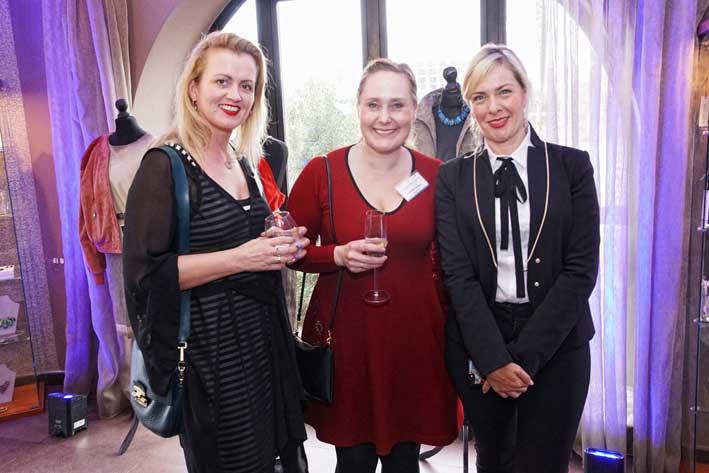I was most intrigued when I received an invitation to the above event but Davinia Mallia Pulé of BuzyMe freelance Marketing & PR Consultancy who was organizing it soon gave me enough information.
To start off with over 50 delegates flew in from over 12 countries from far flung places I have never been to including Greenland, the Faroe Islands, Iceland and Papua New Guinea.
There were some very high profile delegates including ministers and directors of organizations and also designers and inevitably bloggers.
***
The event in fact, was part of a 3-day conference being held in Malta entitled Large Ocean Nations Forum on Blue Growth and was organized by the Government of the Faroe Islands, Nordic Council of Ministers and Nordic Atlantic Cooperation, in close cooperation with FAO and the Commonwealth Secretariat.
***
After delegates and guests were welcomed with canapés and drinks courtesy of Caviar and Bull at the Corinthia San Gorg, Morten Stemre, representative of the Nordic Atlantic Cooperation explained from the podium the concept behind Blue Fashion for Blue Growth. Its objective, he said, is to make fashion and the maritime industry more sustainable and at the same time to create new income generators for the maritime industry. Mr Stemre explained that while, at first glance wearing fish and sealskin products may not be so appealing to the animal lover, it is important to note that these creatures are never killed for their skin. In fact these skins are currently used as cheap fodder or discarded entirely.
***
Minister Herrera addressed the audience and commended this initiative which is aiming to promote sustainable growth in the ocean economy through fashion. He said: "the dovetailing of the fashion industry with the efforts to safeguard the ocean goes to show how the various industries could innovate their practices in such a way which would be more sustainable. Such efforts should be further recognized, celebrated and promoted, in order to ensure that they reach a wider audience."
***
It was now the turn of designers and business owners to present their own case studies.
First on the podium was Marianne Mørck, who is one of the co-founders (together with her daughter) of the Norwegian label Mørck which advocates for natural and traditional materials, Her company wishes to promote local businesses as well as ethical and sustainable production.
Ms Mørck presentation was followed by Dominique Benzaken from the Seychelles who spoke on the Kreolor Enterprise. The brand has been established for 27 years with over 40 employees and six stores. Kreolor jewellery is made with gold and local natural products such as coconut and coco de mer shells, local palm seeds, cultivated pearls and oyster shells.
***

Following an animated coffee break, Malta's own designer, Sam Selby presented her collection of jewellery made from sea sediment. Ms Selby's presentation was followed by that of the three finalists of the Blue Fashion Challenge, which was held at the end of August, in Norway, who presented their collections.
The aim of the Blue Fashion Challenge is to encourage designers from Nordic countries to contribute to a more sustainable textile industry by promoting the use of materials that are bio-based and available on the Islands such as algae and fish scales.
***
The fish industry plays a crucial role in Nordic countries. In the Faroes for example, it represents about 97 percent of total exports. Since the industry inherently farms ocean resources, maximising use of these commodities - including byproduct and leftover waste - makes sense from a sustainability viewpoint. The Faroes have a reputation as a must-see eco travel destination (but they also have a long tradition of commercial whaling.)
***

The Blue Fashion Challenge winner, Ms Sissal Kristiansen from the Faroe Islands, presented her collection. Her brand 'Shisha' creates items that are beautiful but also focus on sustainability and the environment. "Whether it is knitwear, accessories, bags or home accessories, every product has its roots in a culture of the Faroe Islands, the Japanese, the Greelandic or whatever other culture and of people who have inspired me - but the aesthetic guideline will always have the final say," she told the audience. I managed to ambush her when presentations were over and we were enjoying some delicious and different canapés and wine. I had a long and fruitful chat with this gifted woman who showed me a piece of knitting in her bag. She told me that everyone knits on the Faroe Islands and she takes her knitting around with her.
***
The Faroe Islands is a self-governing archipelago, part of the Kingdom of Denmark. It comprises 18 rocky, volcanic islands between Iceland and Norway in the North Atlantic Ocean. There's plenty of rain and plenty of seabirds (so let's keep our hunters away).
***

What I learnt during this conference was entirely new to me. Of course we hear the word sustainability often and I have to say I am no great lover of objects made of old bottles nor of Chianti bottles used as a base to a lampshade - very fashionable in my student days. However, having seen the jacket and bag made of fish skin and so on, I can say I am converted.
This turned out to be a well organized and interesting event. I can no longer look at a fish and not imagine its skin turned into something useful.